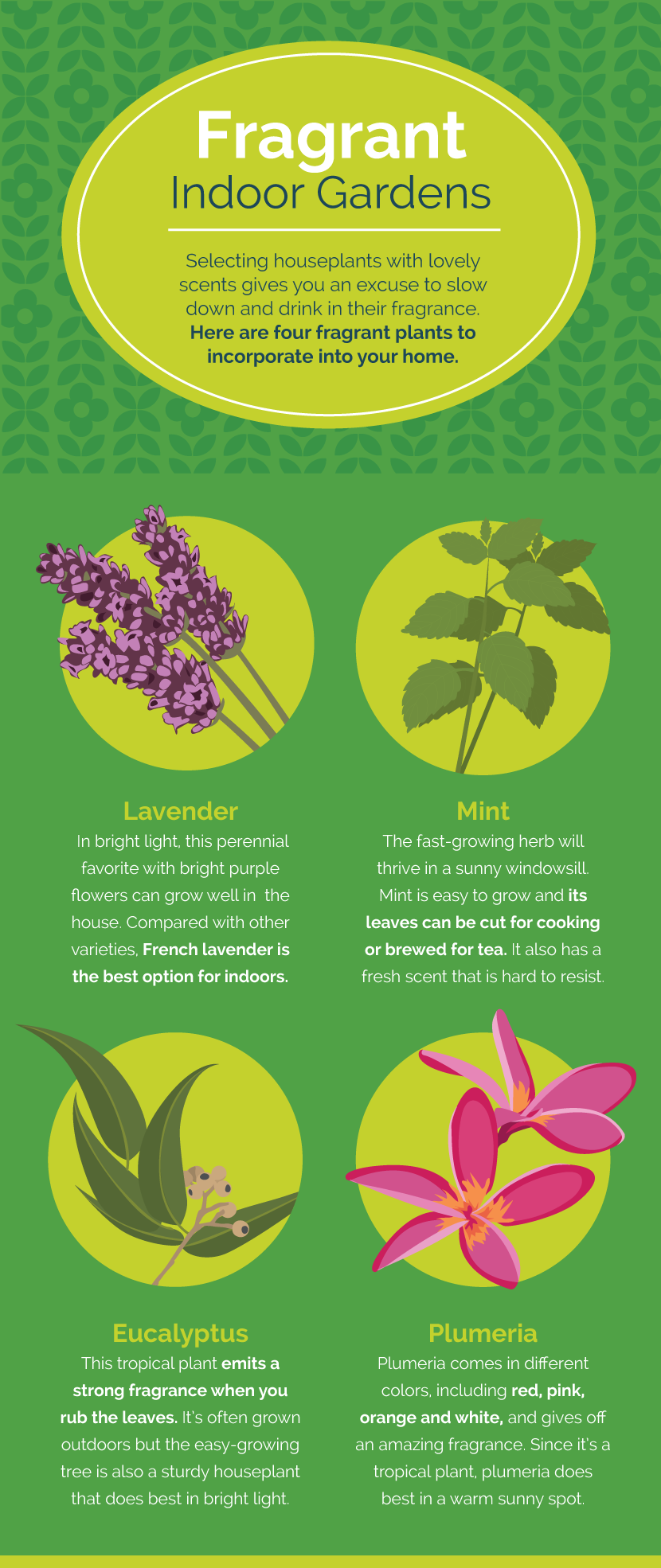Indoor Gardening for Mindfulness
Bring the Sights and Scents of a Garden Indoors
Want to feel happier, more creative, less stressed, and more connected? Buy a houseplant.
The National Gardening Association reported that more than one-third of American homes have indoor plants,
which is no surprise given the abundance of research touting the health and wellness benefits of houseplants.

Go ahead and put a fern in the bathroom, lavender in the kitchen windowsill, or a philodendron on the bedside table. You might notice the following benefits:
A better mood: Do houseplants equal happiness? Researchers seem to think so. Several studies have shown a connection between indoor plants and improved mood.
In one paper, researchers found that those who spent time in a room with a plant rated themselves as more confident and energized compared to those who spent time in spaces without plants.
Less stress: Research published in Preventive Medicine found that placing a plant in a hospital room reduced feelings of stress.
If a potted plant can have that kind of impact in a high-stress environment like a hospital, imagine the feelings of calm it could create at home.
Enhanced creativity: A potted plant could be the key to breaking out of a creative rut.
Researchers at the University of Exeter found that creativity increased 45 percent in spaces with plants.
Go ahead and add a potted plant to your art studio, sewing room, or home office.
Improved comfort: Houseplants do more than make your home look better; they make you feel better when you’re at home, too.
Research shows that houseplants improve indoor air quality by reducing air pollutants, raising humidity levels, removing allergens, and improving indoor acoustics.
When it comes to cultivating happiness in a houseplant, you’re not limited to growing leafy plants in terra cotta pots.
The health and wellness benefits come from tending to living things, so feel free to get creative and choose plants that fit your aesthetics and your lifestyle.
Consider creating a small freshwater garden. Choose floating or submersible plants and a watertight container, like a terrarium jar or aquarium.
For multiple levels of interest, mix submergent plants like elodea and eelgrass,
which can be submersed in water from their roots to their tips, with emergent plants,
which like their roots submerged and their foliage above the waterline (arrowhead and water snowflake are good options), and floaters, which drift on the surface.
Duckweed and water chestnuts are popular floaters.
A fairy garden is a whimsical way to tend to plants indoors. You can add fairies, houses, furniture, animals, plants, and rocks in myriad combinations.
Pick a container (e.g., clay pots, teacups, glass jars, birdbaths, and picnic baskets), choose plants and accessories,
and start creating a miniature world. The only limits are the size of your container and your imagination.
You might want to create an Asian-inspired Zen garden. The most classic designs are made with sand or gravel to represent the ripples in water.
Like the tide, the arrangement of the sand is meant to shift; pulling a miniature rake through the sand changes its pattern and helps create a feeling of calm, hence the name “Zen garden.”
Some Zen gardens also contain succulents or pruned bonsai trees. You can find miniature versions of these at your local garden center.
Get creative with placement – a single plant in a swath of sand has a minimalist appeal.
Remember that both succulents and bonsai trees require a lot of light to thrive so it’s important to place your garden in a sunny spot.
Remember that adding a plant means the Zen garden will need light and water to survive.

Cultivating Mindfulness
Taking care of houseplants also has benefits.
Scientists have discovered a microbe in soil called Mycobacterium vaccae that is believed to be a natural antidepressant.
You breathe in M. vaccae while working in the soil – through activities like repotting houseplants or cutting back dead leaves –
and it triggers the release of the feel-good hormone serotonin, an ingredient in antidepressant medications.
Aside from the boost of serotonin that comes from working in the dirt, caring for houseplants also promotes mindfulness.
You must be in tune with the plant, recognizing when it needs more (or less) water or light, when has outgrown its current pot, or when it is not healthy for other reasons.
Plants also grow and change with the seasons, producing tender new shoots, bursting into bloom in the spring, and going dormant in the winter.
At each phase of their growth, houseplants have distinct needs, such as more nutrients and water during the spring and summer and rest in the winter, and each one has distinct care requirements.
For houseplants to thrive, you must be tuned into – and attend to – their specific needs.
Growing houseplants also promotes awareness of the interconnectedness of all living things.
Plants play an important role in the ecosystem, absorbing carbon dioxide from the environment and releasing oxygen, thus purifying the air you breathe.
Perhaps the most compelling reason behind the benefit they provide is that plants provide a sense of purpose.
Without your care and attention, houseplants will perish. It can be empowering to take on the responsibility of a living thing that depends on you.

Whether you choose lush potted plants, fragrant herbs for your kitchen windowsill,
or creative alternatives like water gardens, growing plants indoors offers benefits for your mind, body, and spirit.
Embed the article on your site

